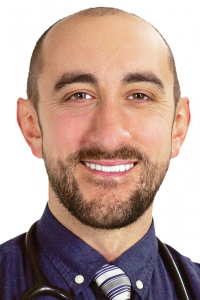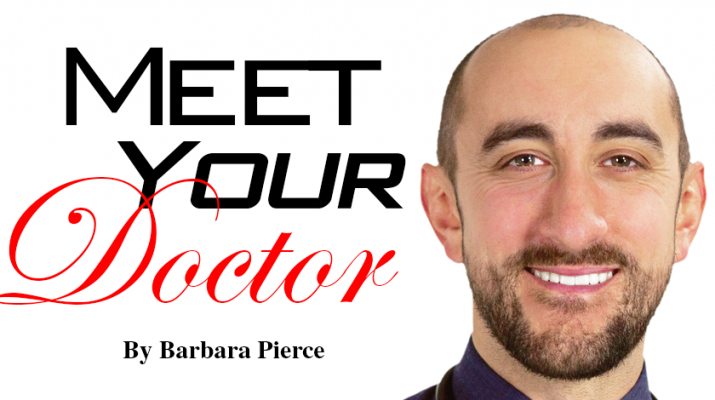Kevin J. Crable, DPM, recently opened Oneida Health Podiatry Care in Oneida, joining Oneida Healthcare’s Circle of Care network. Crable sees patients for surgical and non-surgical treatments of all foot-related conditions. Recently, Mohawk Valley In Good Health senior correspondent Barbara Pierce interviewed Crable regarding his career.
By Barbara Pierce
 Q.: As a podiatrist, what is your goal?
Q.: As a podiatrist, what is your goal?
A.: My goal is to get people back on their feet. Your feet are the most important parts of your body. We tend to take our feet for granted until something goes wrong.
Q.: What training did you have to become a doctor of podiatric medicine?
A.: After earning my Bachelor of Science degree from Fordham University, I had a four-year post-graduate education in podiatry and surgery to earn my DPM, similar to the four-year program a dentist goes through to earn his doctorate in dentistry.
At New York College of Podiatric Medicine, I learned everything about the body and internal medicine, with emphasis on the feet and extremities. After obtaining my DPM degree, I completed a residency at Staten Island University Hospital.
Q.: What influenced you to become a podiatrist?
A.: While attending Fordham University, I was a trainer for the football team. The team had a podiatrist. I shadowed her, was impressed by what she did, and as a result of her influence, decided on this as a profession.
Q.: What is most gratifying about being a podiatrist?
A.: I like being a podiatrist because it’s multifaceted. I’m able to see young people and those who are elderly. I’m also able to treat a variety of problems, from little injuries to more serious conditions.
What’s most rewarding is getting people back on their feet, improving things for them so that they can get through a day without pain, and helping someone get back to being able to do activities of daily living.
Q.: What problem do you see frequently that is easily preventable?
A.: Ingrown toenails are common and unpleasant. They usually happen because people cut their toenails in the wrong way, or cut them too short. The correct way to cut your toenails is straight across, instead of digging in.
Q.: What else do you see that may be preventable?
A.: I see patients who have been diagnosed with diabetes who aren’t aware of the complications the disease can cause. They aren’t aware that the disease can cause foot problems. They are heading down a road where there could be problems.
Q.: What should people with diabetes know about the care of their feet?
A.: People with diabetes especially need to care about their feet. One consequence of diabetes is decreased blood flow to the feet. This makes any minor foot problem, like a new-shoe blister or stepping on a sharp object, slower to heal. Combine that with the nerve damage that diabetes often causes and you might not even notice a worsening infection, which can result in an ulcer that won’t heal.
If you have diabetes, see your podiatrist regularly to keep your feet in good shape, just like you see your ophthalmologist for your eyes. You can head off small problems so they don’t grow into larger ones. How often you should see your podiatrist depends on the level of risk you are at for developing problems. If you are at low risk, it should be every six months.
Q.: We understand the vast majority of those who are aging are likely to have some type of foot problem. What should we know about our feet as we age?
A.: It’s essential to care about your feet as you age. One thing that happens is the blood flow to our feet slows. The blood flow to your lower extremities is compromised. When blood flow is lessened, wounds don’t heal. Small foot problems develop into major problems.
Peripheral vascular disease and peripheral arterial disease are prevalent among older adults. These diseases cause foot pain, cramping, and many other foot and ankle problems.
Q.: What is the most important thing you would like people to know?
A.: Don’t neglect your feet. We don’t think much about them, we take them for granted, but they really are the most important parts of our body, necessary to get us through the day. As soon as you have a concern, seek help. Don’t wait.
Q.: What led you to choose to practice in the Mohawk Valley?
A.: I’m originally from western New York and wanted to move back here. I heard of the opportunity here in Oneida and was excited to take advantage of this opportunity. I’m extremely happy here and I love being here.
Lifelines
Birth year: 1987
Birthplace: Rochester
Current residence: Syracuse
Education: Bachelor of Science degree, Fordham University, Bronx; Doctor of Podiatric Medicine degree, New York College of Podiatric Medicine, New York; residency, Staten Island University Hospital
Affiliations: Oneida Healthcare; CNY Foot Surgery & Podiatry Care P.C.
Personal: Married

